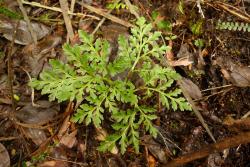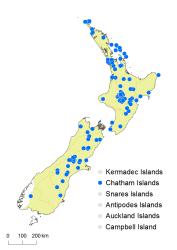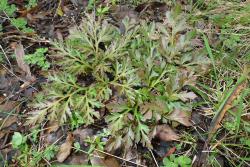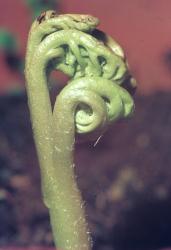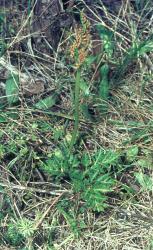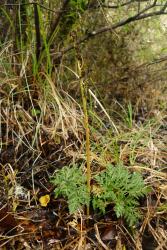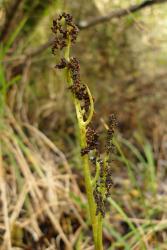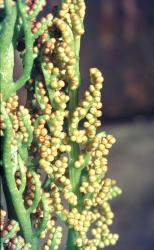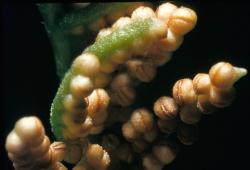- ≡ Sceptridium australe (R.Br.) Lyon, Bot. Gaz. 40: 457 (1905)
- ≡ Botrychium ternatum var. australe (R.Br.) Domin, Biblioth. Bot. 20(85): 224 (1913)
- = Botrychium erosum Milde, Bot. Zeitung (Berlin) 22: 102 (1864)
- ≡ Botrychium ternatum var. erosum (Milde) Milde, Verh. K. K. Zool.-Bot. Ges. Wien 18: 509 (1868)
- ≡ Botrychium ternatum var. australasiaticum γ erosum (Milde) Milde, Verh. K. K. Zool.-Bot. Ges. Wien 19: 157 (1869)
- ≡ Botrychium australe var. erosum (Milde) Prantl, Jahrb. Königl. Bot. Gart. Berlin 3: 340 (1884)
Rhizomes erect, subterranean, 9–50 mm long, glabrous; roots thick, fleshy, ridged and contractile, up to 3.5 mm diameter. Fronds 50–600 mm long, divided into a sterile lamina and fertile sporophore. Stipes 8–100 mm long, yellow-brown to chestnut-brown, glabrous or with a few scattered hairs. Sterile laminae borne on a stalk 7–300 mm long, laminae divided 3–5 times, broadly ovate or pentagonal or broader than long, 20–220 mm long, 30–290 mm wide, green or bronze, fleshy or coriaceous, bearing scattered colourless hairs. Ultimate segments ovate or elliptic or oblong, acute to obtuse, margins entire or with a few blunt serrations, 1.3–5 mm wide. Sporophore held above the sterile lamina, borne on a stalk 37–420 mm long, divided 3–4 times, narrowly ovate to broadly ovate, 20–180 mm long, 10–80 mm wide, fleshy or coriaceous, bearing a few scattered colourless hairs. Sporangia sessile or subsessile, clustered on branches of the sporophore, 0.6–1.1 mm diameter.
Botrychium australe is very similar to B. biforme in overall shape and size but is distinguished by its slightly less divided frond, and by the ultimate segments which are broader (1.3–5 mm wide) and acute or obtuse compared to those of B. biforme which are narrower (0.2–1 mm wide) and acuminate. Both species have green and bronze colour forms, and have large fleshy roots containing starch, but only in B. australe are they ridged and contractile (Braggins 1980).
North Island: Northland, Auckland, Volcanic Plateau, Gisborne, Taranaki, Southern North Island.
South Island: Western Nelson, Sounds-Nelson, Marlborough, Westland, Canterbury, Otago, Southland.
Chatham Islands.
Altitudinal range: 0–1200 m.
Botrychium australe is widespread, but generally uncommon, in lowland, montane and subalpine areas of the North Island from Te Paki to Cook Strait, extending from near sea level to 1150 m in the Kaimanawa Ranges. However, it is more abundant in the central North Island where it occurs in a zone from 500 to 1150 m above sea level. In the South Island it is found east of the main divide, largely confined to the northern half of the Island, with only scattered records between Arthur’s Pass and Te Anau. It occurs sporadically in lowland areas from 250 to 500 m, but is most frequent in montane and subalpine areas above 500 m; it reaches 1200 m on Mt Ida, near Naseby. Botrychium australe and B. biforme sometimes occur together, but only B. australe occurs north of the Waikato.
Also Australia (Queensland, New South Wales, Victoria, Tasmania; extinct in South Australia), Lord Howe Island, Argentina, Chile. In South America, subsp. australe and subsp. negeri (H.Christ) R.T.Clausen are recognised as separate taxa (Zuloaga et al. 2008), but the distinction between them, and their relationship to Australasian material, requires further investigation.
Botrychium australe is a plant of disturbed habitats, occurring under mānuka, kānuka and matagouri scrub and broadleaved forest, and in open areas on river flats, track sides, in bush clearings, frost flats and around bush margins, in grassy areas, peat bog, herbfield and in reverting pasture. Plants occur singly or in large patches, but populations are often widely separated; they die down completely in winter, emerging again in spring from the underground rhizome. Braggins (1980) noted that the contractile roots may aid survival in exposed sites and that the fleshy roots provide a reservoir of starch, enabling plants to regrow after damage to the frond.
n = 45 (Brownlie 1958); 2n = 90 (Braggins 1980; de Lange et al. 2004).
The names Botrychium virginicum Willd., B. cicutarium Sw. and B. ternatum (Thunb.) Sw., and combinations based on them, have been widely misapplied by earlier authors to Botrychium australe in New Zealand.



